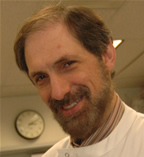The Antibiotic Resistance Conundrum
"The development of new drugs has not kept up with the development of resistance by bacteria... many people are dying from diseases that they shouldn’t be dying from..."
September 15, 2006
“When antibiotics were first developed in the 1940s, scientists
believed that we were going to wipe out bacterial infections. Now we know
that is not the case,” said Marcelo Tolmasky, professor of biological
science.
“In
the past when an antibiotic lost its effectiveness there was another one available.
However, the development of new drugs has not kept up with the development
of resistance by bacteria. At the moment, we are concerned that the balance
is tipping in the bacteria’s favor. In the United States, many people
are dying from diseases that they shouldn’t be dying from,” explained
Tolmasky, who is researching into strategies to extend the life of existing
drugs in ways that make them more resistant to bacteria.
The National
Institutes of Health recently awarded $209,000 in support of Tolmasky’s
efforts.
Casual or
improper use of antibiotics compounds the problem of antibiotic resistance,
he noted. Another difficulty is that many people stop taking medicine when
they start feeling better, instead of finishing the prescription, Tolmasky
added. “All that is needed is for a bacterium to acquire resistance
to an antibiotic — and it spreads that attribute [trait] to other cells.”
Some scientists
are concerned the plethora of antibacterial products used by consumers, such
as soaps, detergents and cleaning products, are furthering the problem. There
also is some trepidation that meat and dairy products we consume may play a
role in the resistance dilemma, said Tolmasky, who noted that the FDA’s
National Center for Toxicological Research is studying the effects of ingesting
animal products that carry antibiotics residuals.
“The
situation is compounded by the fact that, “in other countries, antibiotics
are sold over-the-counter. People take antibiotics in situations where they
are completely useless,” Tolmasky pointed out. “Then when they
get sick, they take an antibiotic and it’s ineffective. They become a
carrier of the resistant bacteria and may not even know it, because you don’t
have to be sick to spread the pathogen. All that person needs to do is to shake
hands and the resistant bacteria are spread throughout the community.
“When
I started to research antibiotic resistance in the 1980s, it wasn’t a
very popular area of research; there was little concern about bacterial resistance,” said
Tolmasky. “I decided to do this research because of what was happening
at Childrens Hospital in Argentina. Antibiotics that very efficient in the
treatment of certain kinds of bacterial infections started to lose their power.”
“Bacterial
resistance usually starts in the hospital,” said Tolmasky, who earned
his doctorate from the Institute for Research in biochemistry at the University
of Buenos Aires before joining Cal State Fullerton in 1995.
According
to the Centers for Disease Control, around two million people in the U.S. contract
a bacterial infection while hospitalized: of those afflicted, about 90,000
die. The federal agency estimates that more than 70 percent of disease-carrying
bacteria are resistant to one or more antibiotics.
“Bacterial
infections can spread very quickly,” Tolmasky pointed out. “For
example, cholera appeared in South America in 1991, and quickly spread to several
countries. If the pathogen is resistant, the problem is compounded.”


 Produced by the Office of Public Affairs at California State University, Fullerton.
Produced by the Office of Public Affairs at California State University, Fullerton.